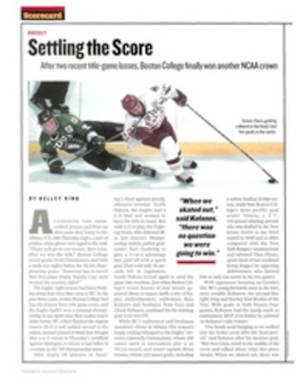
Notebook
Range Net Raised Again
Screen Monster
the 180-foot-long, 105-foot-tall net at the end of the Augusta
National practice range rises out of the Georgia pines like a
giant. Though big and bold in scale, the clingy contraption can't
claim to have a Christo-like effect on the landscape. It's an
eyesore, but without it cars passing on Washington Road, which is
40 feet on the other side of the net, would face a hail of golf
balls during Masters week.
Before this year's tournament, the net, which is supported by 12
wooden poles that are painted green and spaced about five yards
apart, was raised 10 feet in anticipation of the extra distance
players have gained from high-tech balls and drivers. Set 255
yards from the tee, the net gently absorbed almost every big
drive during the week. Bombers such as Tiger Woods and Davis Love
III abided by Masters officials' wishes that they hit their
drivers diagonally across the range to avoid breaking any
windshields. Only amateur D.J. Trahan, pumped for his first
Masters, gave in to the fans' goading and took the straight line
over the middle of the net.
Trahan's blasts were a clear indication that the net will have to
be raised again soon. In fact, the net's periodic growth spurts
reflect the rapid advances in golf technology over the last two
decades. For a half century after the tournament's inception in
1934, a low fence was enough to keep all but the biggest hitters
in the ballpark. Players practiced with their own shag balls, and
their caddies caught them with a baseball glove or a towel. When
a long ball cleared the fence and headed toward the old Piggly
Wiggly across Washington Road, the caddie twirled his towel
overhead to signal a home run.
George Bayer and Jack Nicklaus set off plenty of towel waving in
the 1950s and '60s, as did Tom Weiskopf and a few others in the
'70s. By 1980 the quality of golf balls had improved to the point
that dozens of players were reaching Washington Road, so in 1982
the screen, set at a height of 50 feet, was installed.
The Screen Monster didn't grow very fast in its early years, in
part because a 250-yard drive was respectable, in part because
showboating was frowned upon. "Sure, I could knock it over, but
what was the point?" says Nicklaus. But in 1992 John Daly,
playing in his first Masters, was prodded to swing for the fence
by a throng of spectators in the driving-range grandstand. Daly
responded by pelting a bevy of balls over the screen. Remarkably,
no damage was reported. "It gives the crowd something to cheer
about," Daly said at the time, "and I was trying like hell. It's
a little bit of a thrill for me too."
The next year the screen was raised to 65 feet. When Woods played
in his first Masters, as an amateur in 1995, he couldn't resist
trying to hit one over the screen. The day before the first
round, Woods was on the range practicing when Love prodded Tiger
into an impromptu ball-bashing contest. After Love hit the top of
the screen, Woods hit a rocket that got out in a hurry, drawing
amazed laughter from Love and several other players who had
stopped to watch.
The club raised the net to 85 feet in 1998, and tournament
director Will Nicholson asked players to refrain from bombing
balls over it. Eighty-six players obliged, while two others--Daly
and Matt Kuchar--did not. The net reached 95 feet in '99 and was
up to 105 feet last week. "I've seen more balls fly out in the
last few years than ever before, but fewer this year," says Mason
Clements, the driving-range supervisor at the Masters for the
last six years. "I'm glad they keep raising it. I've never heard
of anyone getting hit, but the club is making sure it doesn't
push its luck."
Altering Augusta
Only two years after its last major overhaul, Augusta National
will undergo another. Masters chairman Hootie Johnson, citing the
distances players can drive the ball, conceded last week that
"four or five of our par-4s are a little weak" and said architect
Tom Fazio will alter them before next April.
Focusing on the par-4s is shrewd because the 6,985-yard
National's par-3s and par-5s, though short, provide the most
drama. Johnson didn't specify which holes will be changed. The
most obvious candidates would appear to be the two shortest
par-4s, the 350-yard 3rd and the 365-yard 7th, but both require
exacting approach shots. Lengthening them would eliminate an
element of artistry from the course. Instead, look for changes,
marked in yellow, on the following holes.
No. 1
410 Yards
WEAKNESS The big fairway bunker is easily carried, leaving a
short iron in.
SOLUTION Move the tee back 20 yards to bring the bunker into
play and tighten the landing area. If you lay up, you'll have a
semiblind mid-iron approach from an uphill lie.
No. 5
435 Yards
WEAKNESS The hole used to be feared because it demanded a four-
or five-iron approach to a difficult target, but now long
hitters cut the dogleg and hit a wedge in.
SOLUTION A large fairway bunker should be placed on the right
side of the fairway, forcing those who try to cut the dogleg to
flirt with the trees on the left. That'll make laying up the
smart tee shot.
No. 9
430 Yards
WEAKNESS Players blow their drives down a steep hill to a
wide-open area in the right rough, leaving a short iron with a
good angle to the green.
SOLUTION Moving the tee back 20 yards will stop balls from
kicking off the downslope. Long drives will leave a downhill lie
to an uphill green. If you lay back for a flat lie, you'll need a
long iron to get home.
No. 11
455 Yards
WEAKNESS Like the 5th, the 11th used to be one of the best par-4s
in golf, but today's players can carry their drives to the
downslope, leaving a short pitch to the green.
SOLUTION With the tee moved back 10 or 15 yards, a player won't
get as much roll on his drive and will be left with a mid-iron
approach. As in the old days, the pond to the left of the green
will be scary.
No. 14
405 Yards
WEAKNESS Although the fairway is narrow, the hole is simply too
short.
SOLUTION Enhancing the dogleg by moving the tee left would make
the left-to-right sloping fairway too hard to hold, so trees need
to be removed to the left of the fairway. The objective: create
an approach long enough to make the huge hump in the front of the
green a concern.
No. 18
405 Yards
WEAKNESS Today's long hitter can either drive over the two
massive fairway bunkers into the left rough, where there's tons
of room, or hit a power fade over the traps and have a wedge in.
SOLUTION Move the tee back far enough to bring the bunkers into
play for everyone. That will leave a seven-iron or more from an
uphill lie.
COLOR PHOTO: ROBERT BECK Masters officials have asked the players not to hit over the netting, but not everyone has complied. 2001 105 ft. 1999 95 ft. 1995 85 ft. 1993 65 ft. 1982 50 ft.
COLOR PHOTO: JIM MIDGETT
COLOR PHOTO: F. CARTER SMITH
COLOR PHOTO: STEVE SPATAFORE
SIX COLOR ILLUSTRATIONS: ILLUSTRATIONS BY GIACOMO MARCHESI
Trust Me
No, Tiger Woods's run of four straight majors is not a Grand
Slam. Counting his win in the Players Championship, I call it the
Quintessential Quintuple. If Woods wins the U.S. Open in June,
his majors streak will surpass Byron Nelson's 11 consecutive
victories as the greatest feat in the history of golf. I would
then bet on him to complete the Slam this year because his
special gift is this: The more he wants it, the better he plays.
Foursomes
What do these players have in common?
Ben Hogan
Jack Nicklaus
Arnold Palmer
Craig Wood
They're the only men to win the Masters and the U.S. Open in the
same year. Hogan did it in 1951 and '53, Nicklaus in '72, Palmer
in '60 and Wood in '41.
Feedback
Should Arnold Palmer serve as an honorary starter at the Masters
Yes 83%
No 17%
--Based on 21,783 responses to our informal survey
Next question:
Will Tiger Woods win all four of this year's majors?
Vote at golfplus.cnnsi.com.
Thesaurus
Synonyms for: A wild shot
Air Canada, AMF, H&R Block, in the lumberyard, into orbit,
lateral, left of Lenin, next zip code, off the world, Oscar
Brown's farm, reload, right of Rush, roof rattler, RuPaul,
serious vector, WTFL, WTFR.
Numbers
In 1999, Augusta National added 25 yards to the 2nd and 17th
holes, rebuilt the 11th green and planted a grove of trees right
off the 15th fairway. Here's the stroke averages on those holes
for the three years before and the three years after the
modifications.
1996-98 1999-2001
2nd 4.82 4.84
11th 4.16 4.25
15th 4.94 4.89
17th 4.07 4.23
Faces
Lauren Espinosa, Irving, Texas
Randy Lowry, Spring, Texas
Lauren and Randy, each 14, won second consecutive girl and boy
player of the year awards, respectively, in the 13 to 15 age
division of the Texas Junior Golf tour, a 13-event winter
circuit. Lauren took seven tournaments by an average of 10.4
strokes and finished in the top five in her other four starts.
She is the reigning Texas state champ in the 12 to 14 age
division. Randy was victorious in eight TJGT events, including
the season-ending Tour Championship, and led the circuit with a
74.8 scoring average. Last October, Randy prevailed by 15 shots
in his age group at the Houston Golf Association's Fall Open, and
in December he won by seven at the Future World Collegiate Tour's
Longhorn Junior in Austin.
Brady Exber, Las Vegas
Exber, 45, a part owner of two casinos, El Cortez and the Las
Vegas Club, fired a one-over 145 for a four-shot victory at the
Black Mountain Amateur in Henderson, Nev. The reigning Las Vegas
City and Nevada Mid-Amateur champ, Brady has been the Southern
Nevada Golf Association amateur player of the year the last three
seasons.
Submit Faces candidates to golfplus.cnnsi.com/faces.

